
Augustinians are members of Christian religious orders that follow the Rule of Saint Augustine, written in about 400 AD by Augustine of Hippo. There are two distinct types of Augustinians in Catholic religious orders dating back to the 12th–13th centuries:
Canons regular are priests who live in community under a rule and are generally organised into religious orders, differing from both secular canons and other forms of religious life, such as clerics regular, designated by a partly similar terminology.
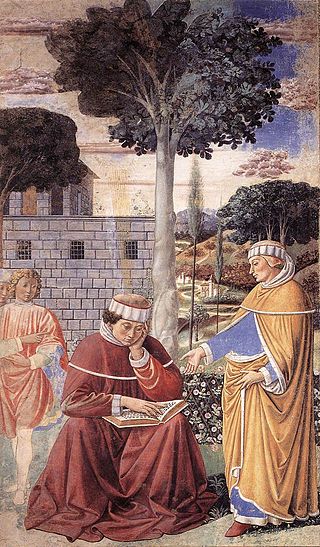
Alypius of Thagaste was bishop of the see of Thagaste Algeria) in 394. He was a lifelong friend of Augustine of Hippo and joined him in his conversion and life in Christianity. He is credited with helping establish Augustine's monastery in Africa. Most of what is known about him comes from Augustine's autobiographical Confessions.

The Province of the Most Holy Name of Jesus of the Philippines(Spanish: Provincia Agustiniana del Santísimo Nombre de Jesús de Filipinas) was a geographical and administrative subdivision of the religious Order of St. Augustine that was formally affiliated to the Order on March 7, 1575, to originally cater the needs of the growing Augustinian presence in Philippines who were serving Filipinos in more than 300 towns in the 16th century. The Province later on expanded its presence in East Asia, Africa and the Americas in the 20th century to help build and serve more communities. It was considered to be the largest province in the whole Augustinian Order, with more than 300 affiliated Augustinian friars working in The Philippines, Spain, Tanzania, India, Venezuela, Peru, Costa Rica, El Salvador, Honduras, and China, according to a 2018 statistic from the Province.

Agostino Novello, also known as Augustine of Tarano, but born Matteo da Termini, was an Italian religious figure. He was born in the first half of the 13th century, at Termini Imerese, the village in Sicily from which he derived his surname. As that village was near Palermo, he is sometimes called Palermitano. The Augustinians believe he was probably born at Tarano. On entering religion he changed his name to Agostino, and later was given the additional name of Novello.

St Augustine's College, Sydney is an independent Roman Catholic single-sex primary and secondary day school for boys, located in Brookvale, on the Northern Beaches of Sydney, New South Wales, Australia. The school caters from approximately 1,200 boys in Year 5 to Year 12 with an education ethos of Augustinian. It was founded by the Priests of the Order of St. Augustine and is situated directly opposite Brookvale Oval.
Genazzano is a town and comune in the Metropolitan City of Rome, located on a tuff spur at 375 metres (1,230 ft) above sea level that, starting from the Monti Prenestini, ends on the Sacco River valley.
Independent Augustinian communities are Roman Catholic religious communities that follow the Augustinian Rule, but are not under the jurisdiction of the Prior General of the Augustinian hermits in Rome.
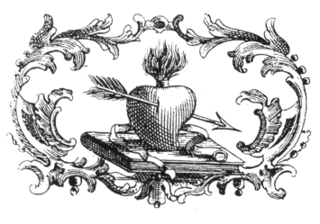
The Order of Saint Augustine, abbreviated OSA, is a religious mendicant order of the Catholic Church. It was founded in 1244 by bringing together several eremitical groups in the Tuscany region who were following the Rule of Saint Augustine, written by Saint Augustine of Hippo in the fifth century.
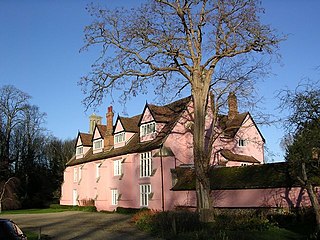
Clare Priory is a religious house in England, originally established in 1248 as the first house of the Augustinian Friars in England. It is situated on the banks of the River Stour, a short distance away from the medieval village of Clare, Suffolk. The friary was suppressed in 1538 and the property passed through many hands until it was again purchased by the Augustinian friars in 1953. Today the Priory offers modern retreat facilities for guests.

John Stone, OSA was an English Augustinian friar who was executed, probably in December 1539; he was canonized in 1970 by Pope Paul VI. He was a doctor of theology from Canterbury.
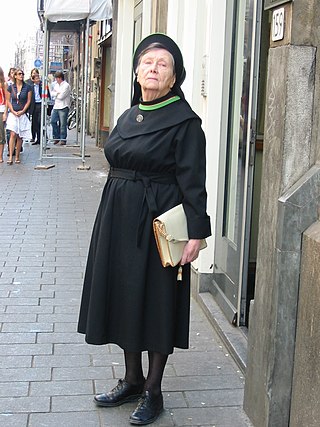
Augustinian nuns are the most ancient and continuous segment of the Roman Catholic Augustinian religious order under the canons of contemporary historical method. The Augustinian nuns, named after Saint Augustine of Hippo, are several Roman Catholic enclosed monastic communities of women living according to a guide to religious life known as the Rule of St. Augustine. Prominent Augustinian nuns include Italian mystic St. Clare of Montefalco and St. Rita of Cascia.

James of Viterbo, born Giacomo Capocci, was an Italian Roman Catholic Augustinian friar and Scholastic theologian, who later became Archbishop of Naples.

Our Lady of Good Counsel is a title given to the Blessed Virgin Mary, after a painting said to be miraculous, now found in the thirteenth century Augustinian church at Genazzano, near Rome, Italy. Measuring 40 to 45 centimetres the image is a fresco executed on a thin layer of plaster no thicker than an egg shell. Over the centuries, devotions to Our Lady of the Good Counsel grew among saints and Popes, to the extent that a reference to it was added to the Litany of Loreto and the devotion spread throughout the world. Her feast day is 26 April.

The St. Nicholas of Tolentine Church is a Roman Catholic parish located in the South Philadelphia neighborhood of Philadelphia, Pennsylvania within the Archdiocese of Philadelphia. St. Nicks is one of two remaining ethnically Italian parishes in the South Vicariate, the other being St. Donato's of West Philadelphia. Both parishes give Mass in Italian, as well as English, and consist of a heavily Italian American congregation. The church is located on 9th and Watkins' Streets in South Philadelphia.
The Marylake Augustinian Monastery, also known as Marylake Monastery, Marylake Shrine, or simply Marylake, is an Augustinian monastery in King City, Ontario, Canada. The campus is nearly 1,000 acres (4.0 km2), residing on Keele Street, just north of 15th Sideroad (Bloomington). It is part of the Province of Saint Joseph, the Canadian province of Augustinians which operates under the jurisdiction of the Chicago-based Province of Our Mother of Good Counsel.
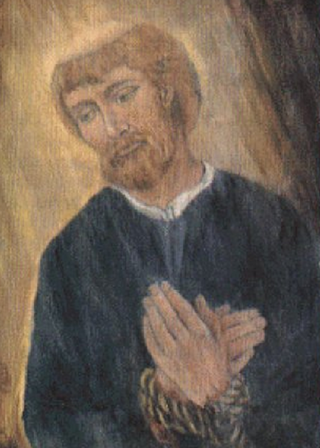
William Tirry OSA was an Irish Roman Catholic priest of the Order of Saint Augustine following the Cromwellian conquest of Ireland. He was captured by the priest hunters at Fethard, County Tipperary while continuing his priestly ministry covertly and was hanged at Clonmel, officially for high treason against the Commonwealth of England, but in reality as part of The Protectorate's systematic religious persecution of the Catholic Church in Ireland. Pope John Paul II beatified Friar William Tirry as one of the 24 officially recognized Irish Catholic Martyrs in 1992.

Thomas Galberry was an Irish Augustinian friar and the fourth Bishop of Hartford, Connecticut, serving from 1876 until his death in 1878.
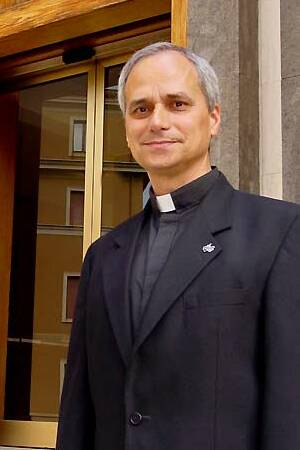
Robert Francis Prevost, O.S.A. is an American-born prelate of the Catholic Church who has served as prefect of the Dicastery for Bishops since April 12, 2023, having been appointed on January 30, 2023. He previously served as Bishop of Chiclayo in Peru from 2015 to 2023. A member of the Order of St. Augustine, he worked in Peru from 1985 to 1986 and from 1988 to 1998 as a parish pastor, diocesan official, seminary teacher and administrator. Prevost headed his order from its headquarters in Rome from 2001 to 2013. He spent the years 1987 to 1988 and 1998 to 2001 in the United States, based in Chicago.

Michael Hurley was an American Catholic priest and an Augustinian friar. He served as pastor of St. Augustine Church in Philadelphia for seventeen years, as vicar general of the American province of the Order of Saint Augustine, and as vicar general of the Diocese of Philadelphia.
















